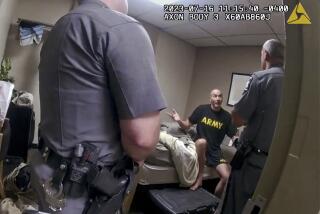Ft. Hood shooter showed ‘no clear warning signs’ before 2014 attack
The U.S. Army specialist who shot and killed three soldiers last year at Ft. Hood, Texas, before taking his own life showed “no clear warning signs” that he might commit a violent act before the April attack, according to a report made public on Friday.
Investigators determined that no single event led to the shooting, according to the report.
They said that nothing in Spc. Ivan Lopez’s medical or military background could have allowed commanding officers to prevent the deadly shooting, according to a U.S. Army statement.
The Army interviewed 169 witnesses during the investigation and determined Lopez had experienced emotional trauma in the months leading up to the deadly clash, including the deaths of two family members, but ultimately found that his commanding officers would not have been able to recognize his mental state.
“Since risk assessment tools depend on self-reporting, they are subject to the soldier’s willingness to identify risk factors accurately,” the report reads, adding that Lopez could at times be “misleading” when discussing his stress with supervisors.
Lopez had been diagnosed with depression, anxiety and sleep disturbances and was being evaluated for post-traumatic stress disorder before the April 2 shooting, which also left 16 people injured.
A law enforcement official also previously told The Times that Lopez made a request for a leave in the weeks leading up to the shooting. The request was denied.
“When they told him, he blew his top,” the official said last year.
In the 110-page report, the Army detailed the argument that precipitated the shooting, which involved Lopez’s requests for time off, supposedly to relocate his family to Killeen, Texas.
The report indicated Lopez did not qualify for leave since he had already obtained housing in the area, and while the report said command staff at Fort Hood could have handled his request “more efficiently,” investigators did not conclude that the argument was the lone cause of the shooting.
“No other soldier could reasonably have foreseen that he would react as he did to the denial of his [request], and none of them had the opportunity to stop him,” the report said. “He alone had the opportunity to avoid the shooting, and he chose not to do so.”
Lopez declined to reveal information that could have alerted supervisors to his mental state, including the burglary of his apartment on the day of the shooting, the report said.
The Army report also concluded that Lopez had not planned the shooting ahead of time.
The report made several recmomendations for preventing future incidents, including a suggestion that soldiers be required to register personal weapons with commanding officers. Lopez purchased two firearms before the shooting, and one was used in the attack, according to the report.
“Some recommendations work to improve information flow in units, between Army medical facilities and between leadership and their soldiers and others deal with safety and security measures, “ said Col. Christopher Garver, a spokesman for Ft. Hood.
Ft. Hood was also the site of a deadly shooting in 2009, when Maj. Nidal Malik Hasan, an Army psychiatrist who had previously expressed his anger over military actions against Muslim insurgents, killed 13 people and wounded 30 others at the Texas military installation.
Follow @JamesQueallyLAT for breaking news
More to Read
Start your day right
Sign up for Essential California for news, features and recommendations from the L.A. Times and beyond in your inbox six days a week.
You may occasionally receive promotional content from the Los Angeles Times.







